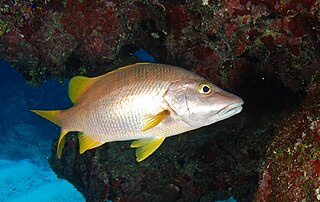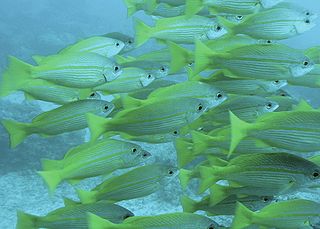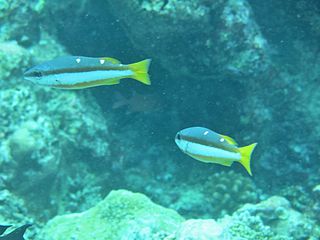
The lane snapper, the Mexican snapper, redtail snapper or spot snapper, is a species of marine ray-finned fish, a snapper belonging to the family Lutjanidae. It is native to the western Atlantic Ocean.

The mangrove red snapper, also known as mangrove jack, grey snapper, creek red bream, Stuart evader, dog bream, purple sea perch, red bream, red perch, red reef bream, river roman, or rock barramundi, is a species of marine ray-finned fish, a snapper belonging to the family Lutjanidae. It has a wide Indo-Pacific range and has recently been recorded in the eastern Mediterranean Sea.

The schoolmaster snapper, is a species of marine ray-finned fish, a snapper belonging to the family Lutjanidae. It is found in the western Atlantic Ocean. Like other snapper species, it is a popular food fish.

The mutton snapper is a species of marine ray-finned fish, a snapper belonging to the family Lutjanidae. It is found in the Western Atlantic Ocean.

The cubera snapper, also known as the Cuban snapper, is a species of marine ray-finned fish, a snapper belonging to the family Lutjanidae. It is native to the western Atlantic Ocean. It is a commercially important species and is a sought-after game fish, though it has been reported to cause ciguatera poisoning.

The bigeye snapper, also known as the bigeye seaperch, red sea lined snapper, golden striped snapper, rosy snapper, yellow snapper, or simply snapper, is a species of marine ray-finned fish, a snapper belonging to the family Lutjanidae. It is native to the Indian Ocean and the western Pacific Ocean. It is the type species of the genus Lutjanus.

Lutjanus is a genus of marine ray-finned fish, snappers belonging to the family Lutjanidae. They are found in the Atlantic, Indian, and Pacific Oceans. They are predatory fish usually found in tropical and subtropical reefs, and mangrove forests. This genus also includes two species that only occur in fresh and brackish waters.

Lutjanidae, or snappers are a family of perciform fish, mainly marine, but with some members inhabiting estuaries, feeding in fresh water. The family includes about 113 species. Some are important food fish. One of the best known is the red snapper.

Lutjanus adetii, the yellow-banded snapper or hussar, is a species of marine ray-finned fish, a snapper belonging to the family Lutjanidae. It is native to the southwestern Pacific Ocean. This species is of minor importance to local commercial fisheries and is sought after as a game fish.

The dog snapper, also known as the dogtooth snapper, pargue or snuggletooth snapper, is a species of marine ray-finned fish, a snapper belonging to the family Lutjanidae. It is native to the Atlantic Ocean. It is a commercially important species, and is popular for display in public aquaria.

The blackfin snapper, also known as the blackspot snapper, blackfin red snapper, gun-mouth backfin, gun-mouth snapper, redfish and wrenchman is a species of marine ray-finned fish, a snapper belonging to the family Lutjanidae. It is native to the western Atlantic Ocean. It is a commercially important species, though it has been reported to carry the ciguatera toxin.

Lutjanus fulviflamma, the dory snapper, blackspot snapper, black-spot sea perch, finger-mark bream, long-spot snapper, Moses perch or red bream, is a species of marine ray-finned fish belonging to the family Lutjanidae, the snappers. It has a wide Indo-Pacific distribution.

Lutjanus russellii, Russell's snapper, Moses snapper, fingermark bream, Moses seaperch or Russell's sea-perch, is a species of marine ray-finned fish, a snapper belonging to the family Lutjanidae. It is native to the western Pacific Ocean.

Lutjanus madras, the Indian snapper, is a species of marine ray-finned fish, a snapper belonging to the family Lutjanidae. It is native to the western Pacific and Indian Oceans.

Lutjanus fulvus, the blacktail snapper, flametail snapper, redmargined seaperch, Waigeu snapper or yellowmargined sea perch, is a species of marine ray-finned fish, a snapper belonging to the family Lutjanidae. It is native to the Indo-West Pacific region. It is an important species for fisheries within its range.

Lutjanus vitta, the brownstripe red snapper, brownstripe snapper, broadband seaperch, brownstripe seaperch, one-band sea-perch, one-lined snapper or striped seaperch, is a species of marine ray-finned fish, a snapper belonging to the family Lutjanidae. It is native to the western Pacific and Indian Oceans.

Lutjanus malabaricus, the Malabar blood snapper, saddletail snapper, large-mouthed nannygai, large-mouthed sea-perch, Malabar snapper, nannygai, red bass, red bream, red emperor, red Jew, red snapper, saddletail seaperch, scarlet emperor or scarlet sea-perch, is a species of marine ray-finned fish, a snapper belonging to the family Lutjanidae. It is native to the Indian Ocean and the western Pacific, where it is found east to Fiji and Japan.

Lutjanus carponotatus, the Spanish flag snapper, stripey snapper, dusky-striped sea-perch, gold-banded sea perch, gold-stripe sea-perch, striped seaperch or stripey seaperch, is a species marine ray-finned fish, a snapper belonging to the family Lutjanidae. It is native to the western Pacific and Indian Oceans, from India to northern Australia.

Lutjanus biguttatus, the two-spot banded snapper or two-spot snapper, is a species of marine ray-finned fish, a snapper belonging to the family Lutjanidae. It is native to the western Pacific and eastern Indian Oceans.

The silk snapper, the West Indian snapper, yellow-eyed snapper or yellow-eyed red snapper, is a species of marine ray-finned fish, a snapper belonging to the family Lutjanidae. It is found in the Western Atlantic Ocean.





















